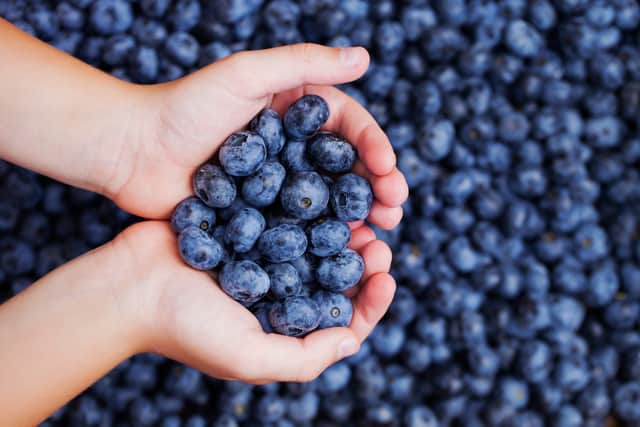5 a day fruit and vegetables target explained - and is it enough to have a healthy diet?
This article contains affiliate links. We may earn a small commission on items purchased through this article, but that does not affect our editorial judgement.


Perhaps unsurprisingly, health has been at the forefront of everyone’s minds during the two years we’ve lived with the Covid-19 pandemic.
But the UK has had an obsession with health and losing weight - particularly at this time of year - since well before most of us even knew what a lateral flow test, let alone a coronavirus, was.
Advertisement
Hide AdAdvertisement
Hide AdYouGov polling on New Year’s resolutions shows that for each of the last three years, the most common goals Brits have set themselves centre around improving fitness, losing weight and eating more healthily.
A key consideration of those targeting the latter of these goals is consuming more fruit and vegetables.


The Government recommends we eat five portions of fruit and veg per day - although where you live in the UK has a major bearing on whether you hit this target.
So what is the 5 a day target - and should we actually be eating more fruit and vegetables than that?
Here’s everything you need to know.
Advertisement
Hide AdAdvertisement
Hide AdWhat is the 5 a day target?
Official advice is that you should eat at least five portions of fruit and veg a day to get enough vitamins and minerals into your diet to lead a healthy life.
A portion is deemed to be:
- 80g of fresh, canned or frozen fruit or veg
- 30g of dried fruit
- 150ml of fruit or vegetable juice or smoothie (can only count once a day due to the potential for such products to contain high concentrations of sugar which cancel out any health benefits)
- 80g beans or pulses (again, can only count once a day as they have little nutritional value)


Rather than weighing out each and every portion of fruit and veg you wish to consume, the following also count as portions:
- one banana, orange, pear or apple or a similar sized fruit
- half a grapefruit or avocado
- a slice of large fruit such as melon or pineapple
- two satsumas, plums or similar sized fruit
- a handful of grapes
- two handfuls of blueberries or raspberries
For more information along these lines, please visit the British Dietetic Association website.
Potatoes, as well as yams, cassava and plantain, actually do not count towards the target because they are starchy foods.
Advertisement
Hide AdAdvertisement
Hide AdBut the NHS still says they should be consumed as part of a healthy, balanced diet because they are good sources of energy.
Where did the 5 a day target come from?
Eating five portions of fruit and veg a day has almost become received wisdom - much like the saying that ‘an apple a day keeps the doctor away’.
But its origins are actually relatively recent, with Tony Blair’s New Labour Government bringing in the policy in 2003 in a bid to boost the population’s health - especially in more deprived parts of the UK.
This target was based on UN World Health Organisation recommendations at the time, which stated that eating 400g of fruit and vegetables a day cut the risk of chronic heart diseases and some cancers.
Advertisement
Hide AdAdvertisement
Hide AdIn 2003, average fruit and vegetable consumption among people reliant on benefits was 2.1 portions a day for men and 1.9 for women.
By comparison, in other households, the averages were 2.8 and 3.1 respectively.
Loading....
While NHS statistics for England show the overall average among adults initially rose, reaching highs of 3.8 portions per day in both 2006 and 2017, there has been little change in fruit and veg consumption since the policy and its accompanying campaign rolled out.
In Scotland, the average sits at just 2.9 portions of fruit and veg per day.
Advertisement
Hide AdAdvertisement
Hide AdIs 5 a day enough to make you healthy?
The emphasis of the 5 a day campaign is that you need at least five portions of fruit and veg in your food every day.
But scientific studies over the years have failed to agree whether this amount of fresh produce is enough or too little.
Two studies in 2014 made different claims about 5 a day.
A study of 65,226 English adults between 2001 and 2008 by University College London (UCL) indicated the more fruit and veg people ate, the less likely they were to die - at any given age.
Seven to 10 portions of fresh produce a day cut the risk of death by any cause over the course of the research period by 42%.
Advertisement
Hide AdAdvertisement
Hide AdIt found fresh veg had the strongest protective effect, followed by salads and then fruit.
But an analysis of 16 world studies published in the BMJ suggested eating more than 5 a day had little impact on mortality.
Each serving of fruit and veg reduced the average risk of death by about 5%, but only as far as five portions a day - not beyond that figure.
Another study of 95 studies in 2017 by Imperial College London then found that 10 portions a day could extend our lives.
Advertisement
Hide AdAdvertisement
Hide AdIn the face of this evidence, eating more fruit and veg it unlikely to harm you, so it’s probably worth getting more into your diet.
A message from the editor:
Thank you for reading. NationalWorld is a new national news brand, produced by a team of journalists, editors, video producers and designers who live and work across the UK. Find out more about who’s who in the team, and our editorial values. We want to start a community among our readers, so please follow us on Facebook, Twitter and Instagram, and keep the conversation going. You can also sign up to our email newsletters and get a curated selection of our best reads to your inbox every day.
Comment Guidelines
National World encourages reader discussion on our stories. User feedback, insights and back-and-forth exchanges add a rich layer of context to reporting. Please review our Community Guidelines before commenting.
